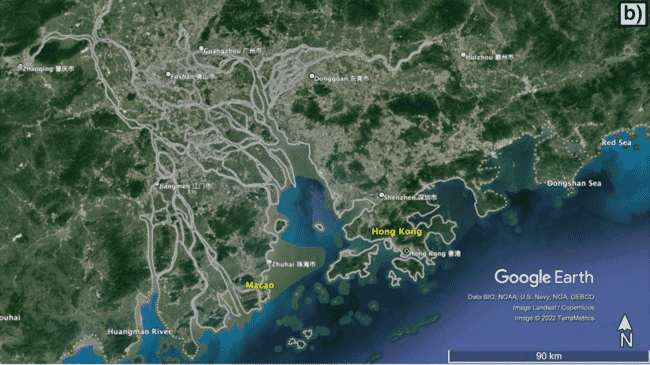
The area is home to a number of mega-cities that are increasingly prone to coastal flooding © NOC
A new study by NOC shows that mangroves – which are shrubs or trees that grow in coastal salt water – are effective at reducing the water level during extreme events, such as heavy storms or typhoons.
Whilst mangroves provide a layer of natural protection, the study also showed that, in order to utilise mangrove-based defences, location-specific numerical simulations are essential to effectively design them. The research was conducted across the Pearl River Delta in the South China Sea which is home to several Chinese mega-cities, such as Hong Kong, Shenzhen and Guangzhou. All three cities are currently experiencing huge growth into areas vulnerable to flooding.
Mangroves can provide coastal protection in the tropical, subtropical, and warm-temperate world. In the UK, other natural habitats, for example saltmarshes, could provide similar coastal protection benefits, but they are still poorly studied.
Dr Michela De Dominicis, senior research scientist in the marine system modelling group at the National Oceanography Centre and lead author on the study, said: “This is an important new study that helps in planning out effective nature-based coastal defences. Mangroves are a vital natural resource at our disposal to protect communities. Even if mangroves on their own do not fully block water flow, they can reduce the extent of the flooding or they can be combined with traditional flood defences such as seawalls and levees, allowing for lower structures.”
The study is especially valuable given that existing research into the controlling factors of how coastal vegetation can reduce extreme water levels is unclear. This means that there has only been a limited implementation of nature-based coastal defences in delta areas housing large cities.
Overall, the study found how effective mangroves are as a nature-based tool to protect coastal areas, as well as highlighting the need for location specific predictions to be made prior to extensive restoration efforts. The study, which was the first of its kind, will inform future research that will consider the amount of storm surge reduction that would make implementation of mangroves a viable investment, as well as considering the other benefits that mangroves offer – such as carbon storage, biodiversity and the prevention of coastal erosion.
Dr De Dominicis added: “This study clears up how mangrove forests change the movement of water in a complex delta plain on a local scale and in areas further away. Mangrove forests are one of the most powerful natural tools we have to protect coastal communities from rising sea levels and severe storms.”


